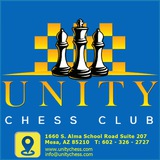The light squares start to creak, and the pieces cannot come to help their king. Black’s attack assumes a decisive character.
Other replies do not help either:
A) 23.f4 Rc2 24.fxe5 Rxg2+ 25.Kh1 Qc2–+;
B) 23.gxh3 Qxh3 24.f4 (24.Be2 Rc6–+) 24...Rc2 25.Rf2 Nf3+–+;
C) 23.Be2 Rc2 24.Bd1 (24.Bh5 Qf5–+; 24.gxh3 Rxe2 25.Bd6 Nf3+ 26.Kh1 d4–+) 24...Rc6 25.f4 Bxg2 26.Rf2 Be4 27.fxe5 Qh3–+.
A) 23.f4 Rc2 24.fxe5 Rxg2+ 25.Kh1 Qc2–+;
B) 23.gxh3 Qxh3 24.f4 (24.Be2 Rc6–+) 24...Rc2 25.Rf2 Nf3+–+;
C) 23.Be2 Rc2 24.Bd1 (24.Bh5 Qf5–+; 24.gxh3 Rxe2 25.Bd6 Nf3+ 26.Kh1 d4–+) 24...Rc6 25.f4 Bxg2 26.Rf2 Be4 27.fxe5 Qh3–+.
23...Nf3+! 24.gxf3 Re4 25.Qxd5 Rxb4 26.Rfd1 Rxb5 27.Qxb5 Rc5 28.Rd8+ Qxd8 29.Qxc5 Qf6!
Unity Chess Club
Konstantin Sakaev 2625 Sergei Vokarev 2505 St Petersburg 2009 White to move
White has full control of the e-file, but Black’s pawn formation is harmonious, and there are no entry squares in his position. At the same time, the Nc4 is cut off from the kingside, and the Bg7 is restricted by both his own pawns and the white chain on c3-d4. Meanwhile, White’s own dark-squared bishop is not a very active piece. This all points to a small sacrifice, which has more of a positional rather than a tactical character.
Black loses time, which allows White to bring the inactive Ra1 into the attack. It was essential to find the problem-like 26...Rh6! 27.Nxf7 Qxf7 28.g4 Rf6 29.Qe8+ Bf8 30.Qxf7+ Kxf7, with a double-edged, roughly equal endgame.
This attempt to hang onto the material meets a refutation.
It was still possible to restore the coordination between his pieces by means of 27...Rdf6, although after 28.Nxf7 Qxf7 29.Qg4+ Kh8 30.f3 White has a lasting initiative, with approximate material equality.
It was still possible to restore the coordination between his pieces by means of 27...Rdf6, although after 28.Nxf7 Qxf7 29.Qg4+ Kh8 30.f3 White has a lasting initiative, with approximate material equality.
The white pieces cooperate excellently, and even with minimal forces are able to create a decisive attack on the undefended black king.
Unity Chess Club
Alexander Morozevich 2769 Hikaru Nakamura 2775 Moscow 2012 Black to move
The exchange of all the major pieces is not so terrible for Black, because he has an outside passed h-pawn. But all the while, the white king remains safe, and it is uncomfortable for Black to continually watch his weak back rank. Therefore, Black gives up one of his doubled pawns, to break up the white king’s cover.
The knight comes to d5 with tempo – this is the ideal square for the attack.
